#islam india
Explore tagged Tumblr posts
Text
In the name of Allah, the Most Gracious, the Most Merciful.
All praise is due to Allah, Lord of all the worlds.
The Most Gracious, the Most Merciful.
Master of the Day of Judgment.
You alone we worship, and You alone we ask for help.
Guide us on the Straight Path,
the path of those who have received Your grace; not the path of those who have brought down wrath upon themselves, nor of those who have gone astray.
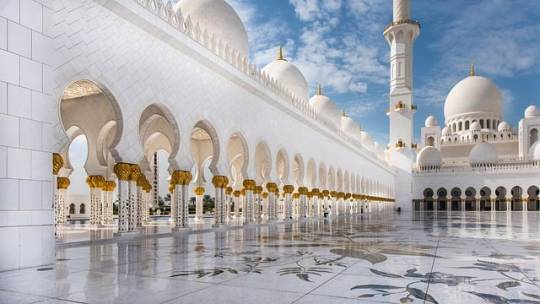
#islam#islamic#islamic shorts#islamic status#islamic cartoon#islamic reminder#islamic video#islamic videos#why islam#christianity vs islam#true islam#islam india#putin islam#what is islam#islamic waz#islam for kids#islam history#power of islam#islam channel#islam science#islam religion#how islam began#islam explained#what is islam and#islam makhachev#islamic short#islam and science#islam (religion)#islamic quotes
8 notes
·
View notes
Text
Emerald Spectacles from India, c. 1620-1660 CE: the lenses of these spectacles were cut from a single 300-carat emerald, and it was believed that they possessed mystical properties

These eyeglasses are also known by the name "Astaneh-e ferdaws," meaning "Gate of Paradise," based on the symbolic associations between the color green and the concept of spiritual salvation/Paradise. That symbolism (which is rooted in Islamic tradition) was especially popular in Mughal-era India, where the spectacles were made.

The lenses were crafted from two thin slices of the same emerald. Together, the lenses have a combined weight of about 27 carats, but given the precision, size, and shape of each lens, experts believe that the original emerald likely weighed in excess of 300 carats (more than sixty grams) before it was cleaved down in order to produce the lenses. The emerald was sourced from a mine in Muzo, Colombia, and it was then transported across the Atlantic by Spanish or Portuguese merchants.
Each lens is encircled by a series of rose-cut diamonds, which run along an ornate frame made of gold and silver. The diamond-studded frame was added in the 1890s, when the original prince-nez design was fitted with more modern frames.
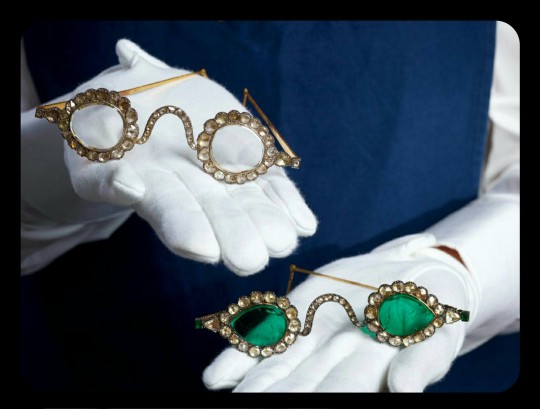
The emerald eyeglasses have long been paired with a second set of spectacles, and they were almost certainly commissioned by the same patron. This second pair is known as "Halqeh-e nur," or the "Halo of Light."
The Halo of Light features lenses that were made from slices of diamond. The diamond lenses were cleaved from a single stone, just like the emerald lenses, with the diamond itself being sourced from a mine in Southern India. It's estimated that the original, uncut diamond would have weighed about 200-300 carats, which would make it one of the largest uncut diamonds ever found.

The lenses are so clear and so smoothly cut that it sometimes looks like they're not even there.
Both sets of spectacles date back to the mid-1600s, and it's generally believed that they were commissioned by a Mughal emperor or prince. The identity of that person is still a bit of a mystery, but it has been widely speculated that the patron was Shah Jahan -- the Mughal ruler who famously commissioned the Taj Mahal after the death of his wife, Mumtaz Mahal. Shah Jahan did rule as the Mughal emperor from about 1628 to 1658.
The emerald and diamond lenses may have been chosen for symbolic, sentimental, and/or cultural reasons, or they may have been chosen simply because they're pretty and extravagant; the original meaning and purpose behind the design is still unclear. Experts do believe that the eyeglasses were designed to be worn by someone, though.
At times, it was believed that the spectacles had spiritual properties, like the ability to promote healing, to ward off evil, to impart wisdom, and to bring the wearer closer to enlightenment. Those beliefs are largely based on the spiritual significance that emeralds and diamonds can have within certain Indic and Islamic traditions -- emeralds may be viewed as an emblem of Paradise, salvation, healing, cleansing, and eternal life, while diamonds are similarly associated with enlightenment, wisdom, celestial light, and mysticism.

The Gate of Paradise and the Halo of Light were both kept in the collections of a wealthy Indian family until 1980, when they were sold to private collectors, and they were then put up for auction once again in 2021. They were most recently valued at about $2 million to $3.4 million per pair.
Sources & More Info:
Sotheby's: Mughal Spectacles
Architectural Digest of India: At Sotheby's auction, Mughal-era eyeglasses made of diamond and emerald create a stir
Only Natural Diamonds: Auspicious Sight & the Halqeh-e Nur Spectacles
The Royal Society Publishing: Cleaving the Halqeh-Ye Nur Diamonds
Gemological Institution of America: Two Antique Mughal Spectacles with Gemstone Lenses
Manuscript: From Satan's Crown to the Holy Grail: emeralds in myth, magic, and history
CNN: The $3.5 million Spectacles Said to Ward off Evil
BBC: Rare Mughal Era Spectacles to be Auctioned by Sotheby's
#history#archaeology#artifact#mughal#india#17th century#art#emerald#diamond#glasses#indian lore#islam#religion#mysticism#indian history#anthropology#spirituality#fashion
5K notes
·
View notes
Text
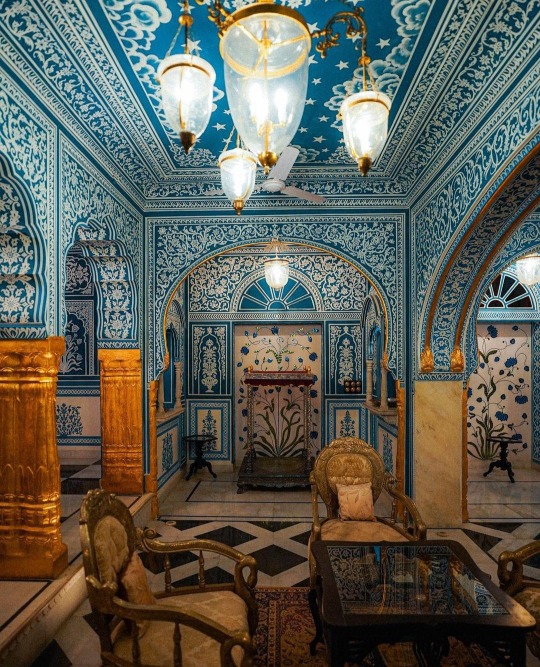
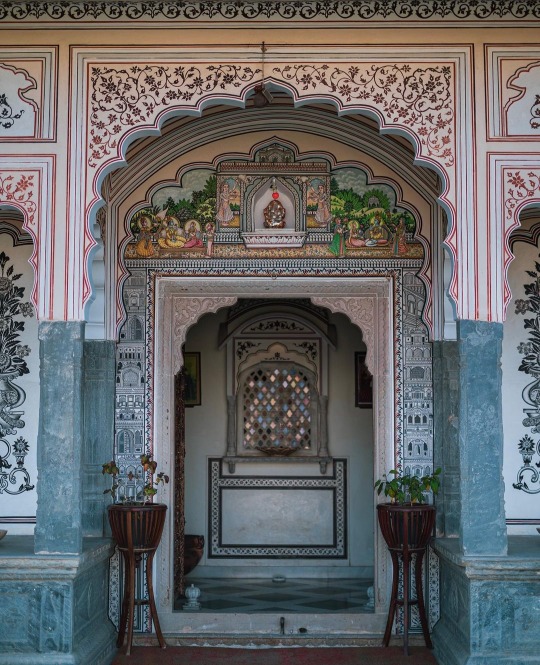
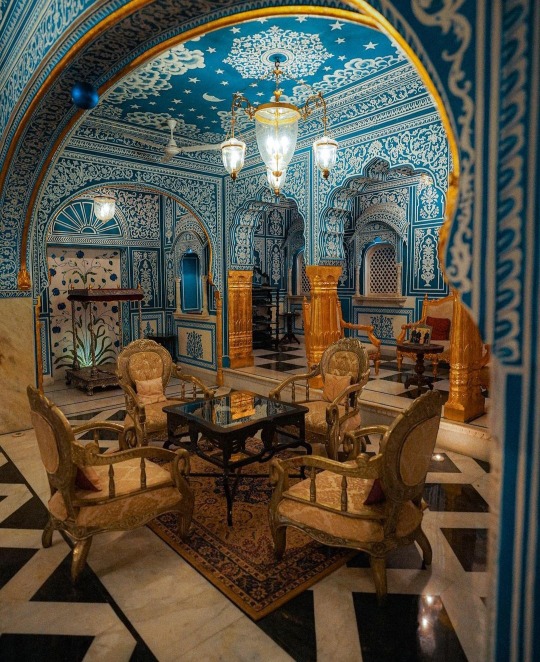


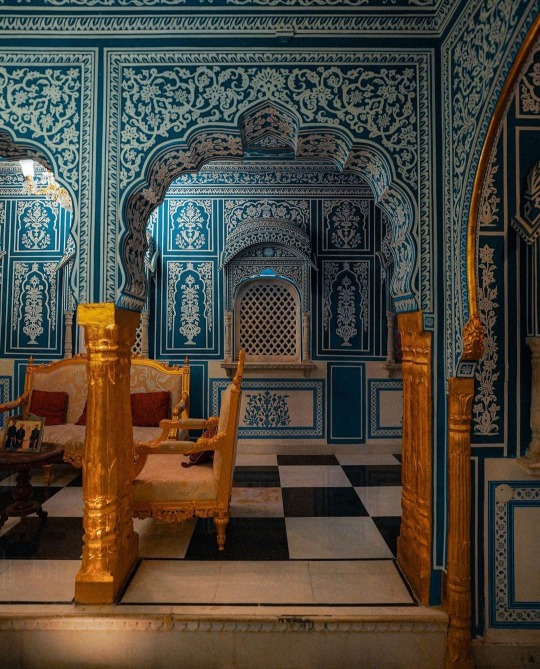
Shahpura Haveli in Jaipur, India.
Maroof Culmen
#maroof culmen#ph#shahpura#jaipur#rajasthan#india#interiors#interior design#maximalism#architecture#islamic architecture#desi tag#desi tumblr#desiblr#desi aesthetic#interior decor#maximalist decor#indian architecture
2K notes
·
View notes
Text

Dilawr Khan Mosque (XV c.) - Mandu, 2013
#original photographers#photographers on tumblr#travel#india#ancient architecture#indian architecture#islamic architecture#architecture#arcade#mosque
257 notes
·
View notes
Text
Now that Ram Mandir has been opened can I honestly share what I feel? No, I'm not on the side of the extremist Hinduism nor am I on the leftists I just want to take a neutral stand here.
To everyone saying it's just a political agenda and Modi is using Ram mandir to appease the Hindu vote bank. Yes, and? I think we all (even the Hindus) know what game he's playing here. My house was conflicted yesterday. My mother and nani (grandma) were sobbing on finally getting Ram lalla's darshan yesterday on TV, my nanu (grandpa) wasn't supporting any of it. And I was torn. Torn between celebrating a historic moment and rationalizing whether it even deserved to be celebrated. His return deserved to be celebrated yes but the extreme Hindus who shower flowers with one hand and with the other hand throw stones on innocent Muslims of today who never took away our beloved Ram ji away in the first place. Would Ram ji have wanted this? He would've wanted us to celebrate yes but not at the cost of harming others. I condemn the acts of discrimination against the minor sects of society, everyone who's got to suffer because of this. In Mahabharata too, the minority (Pandavas) had to go through hell but they emerged victorious in the end coz they were right. However, I'd also like to state that it's not that simple here. People calling out Islamophobia, I'm with you. People calling out Hinduphobia, I'm ALSO with you. All lives matter no matter if they are Hindu or Muslim or Christian or Palestinian. "Hinduphobia doesn't exist" It does. Ofc not at the scale of the terrifying Islamophobia in India but it does. In other Islamic etc countries, it does. Just like how Islamophobia exists in countries where Islam folk are in minority. But does that give Hindus a license to endorse and impose themselves any more than the colonizers and invaders did? No.
You can't blame innocent Muslims for what Mughal invaders did centuries ago any more than you can blame Vibhishan for what his own brother Raavan did. But whoever is on the side of wrongdoing no matter their caste, creed or religion is just as much of a criminal like Karna was with Duryodhana even though he was a Pandava by birth.
Yk I've grown up in my remote, countryside hometown where they play azaan in mosques every day morning and evening and kid me since then became so used to it that it would feel like something is missing if I'd not hear it in the background somewhere while swinging around near the trees or while just walking on the terrace and watching the distant sunset. I'm a Hindu but well, that's just personal nostalgia.
Not all muslims are terrorists. Not all Hindus are fascists. But for those who are, I'd let Karma take care of you all.
I stand with humanity.
Jai Shri Ram 🙏
Allahu Akbar 🙏
#desiblr#desi#ram mandir#ayodhya#hinduism#hindublr#islam#islamophobia#hinduphobia#india#hindutva#desi culture#religion#desi aesthetic#desi tag#desi dark academia#desi girl#desi stuff#desi academia#just desi things
323 notes
·
View notes
Text
Bangladeshi Hindoos Protesting
Jai Maa Kaali🔱🔱




#hindublr#hinduism#hindu genocide#desiblr#hinduphobia#bangladeshi hindus#bangladesh student protests#stop genocide#stop the genocide#islamist#islamic jihad#islamic terrorism#save bangladeshi hindus#savehindus#india#kali maa#maa kali
135 notes
·
View notes
Text

Interior of the Hammam at the Red Fort, Delhi, Furnished According to English Taste, unknown artist, c. 1830-1840, watercolor.
#19th century art#19th century#interior#interior design#red fort#delhi#islamic architecture#period design#watercolor#painting#art#artwork#art history#india#indian architecture#colonial india#architecture#islamic design#hammam#living room#design#period decor#decor#drawing
25 notes
·
View notes
Text
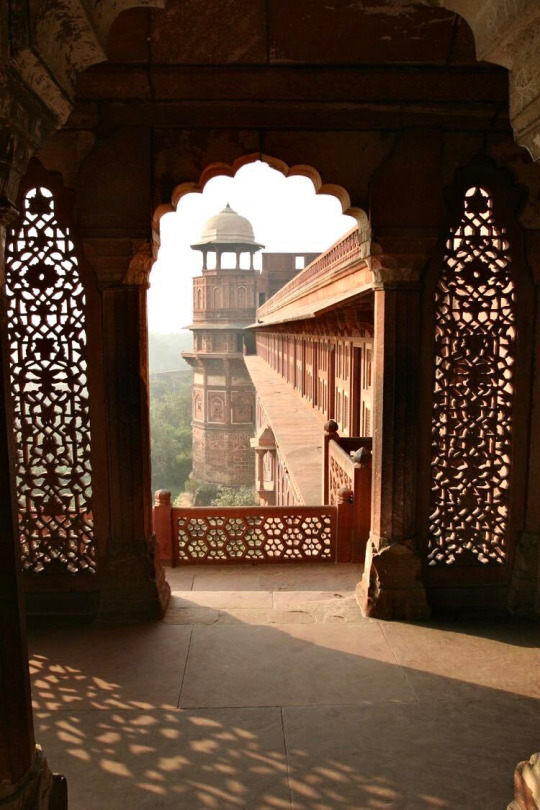
Agra Fort, India: A 16th-century red sandstone Mughal fortress, blending Hindu and Islamic architecture.
806 notes
·
View notes
Text
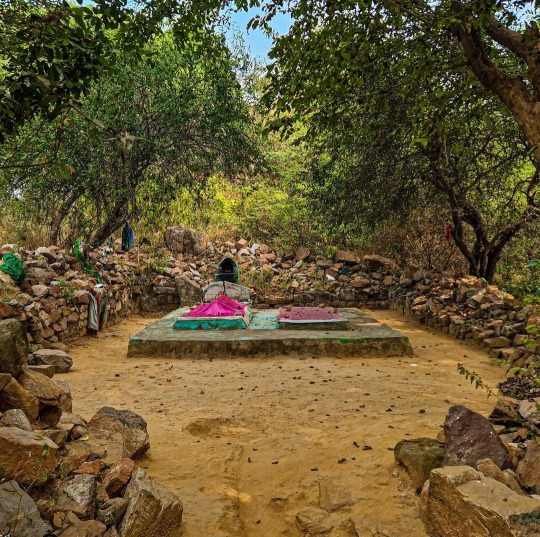
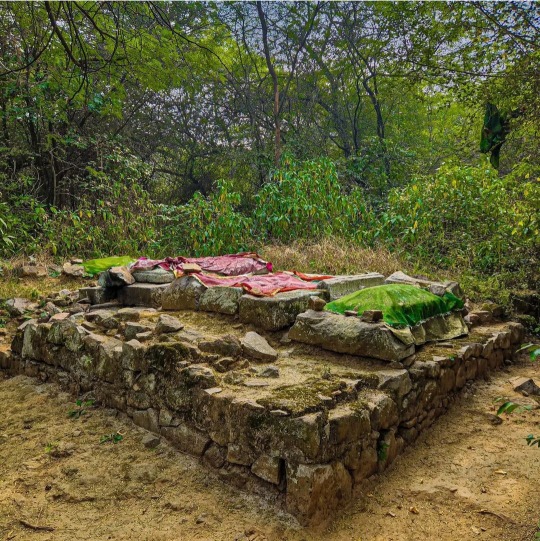
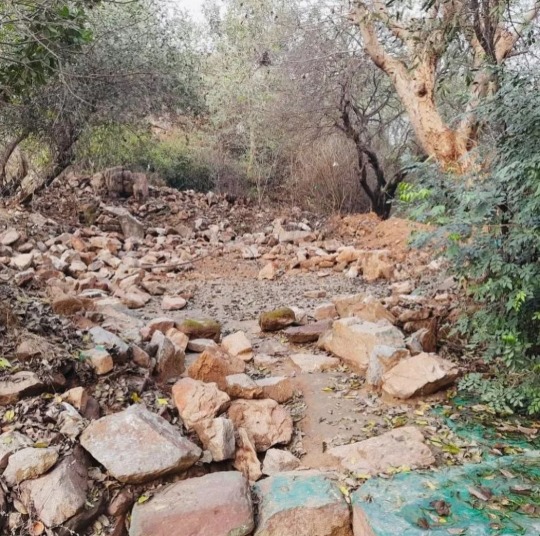
The oldest Sufi shrine in Delhi has been demolished.
"The earliest Sufi Shrine in Delhi - belonging to a relative of Prithviraj Chauhan and dating from BEFORE the Turkish conquest - has been Demolished by the Delhi Development Authority in an "anti encroachment" drive.
In the late 12th century, a group of Afghan pastoralists, suddenly burst onto the world stage. In a matter of years, they toppled their rulers of Ghazni and seized major Persian cities like Herat, and then established the major Indian sultanate in Delhi.
We often think of this "Islamic invasion" as the start of the Muslim presence in India. Yet recent scholarship has shown that by the time of Ghori's conquest of Delhi, Muslims were already a central part of Indian society
Some of the earliest mosques are found in Kerala, dating from a few decades after the prophet Muhammad's death. Tamil Pallava, Chola and Pandya kings all built sizeable mosques
Delhi also had a single sufi shrine before the Afghan conquest - this one.
Until 31 January, when it was demolished, the shrine of Baba Haji Rozbih had been located by the Fateh Burj, or Victory Gate of Lal Kot. The grave next to it under a reddish Chador belongs to his female disciple Bibi. Bibi was said to be a close relative of Prithviraj Chauhan who embraced Islam under the aegis of Haji Rozbih.
This demolition is an UTTERLY MINDLESS LOSS and complete cultural desecration.
What's more the "anti encroachment" drive is apparently scheduled to include the Aashiq Allah Dargah dated to 1317AD which is where the great Punjabi Saint Baba Farid used to meditate, and his small 'chillagah' is still visible here.
Please do share and write about this so we can save what remains! "
- from the historian Sam Dalrymple .
...
This is the third Islamic structure to be demolished in Delhi this month. Isn't it funny how only certain structures are the victim of anti- encroachment drives? This is part of a planned programme by the current right-wing government of India that is violently islamophobic and wants to create a hindu ethnostate modeled after Israel.
#india#desi tumblr#desiblr#south asia#punjab#sufi#sufism#islam#delhi#new delhi#anti-hindutva#anti-bjp#islamophobia#anti hindutva#anti bjp
170 notes
·
View notes
Text

Hindu Male Muslim Female (HMMF) Couples
HMMF Love
🧡🕉️ 💚☪️
#India#kiss#Hindu#Hmmf#Hindu Muslim Love#Muslim Woman#Hindu Man#Love#Interfaith Harmony#Hindu Uncut#Hijab#Hijabi#Hijab Fashion#Namazi#Interfaith Love#Interfaithxxx#Hstud#Hindu Supremacy#Hindu Superiority#Islam#Couple Photography#Romance
37 notes
·
View notes
Text






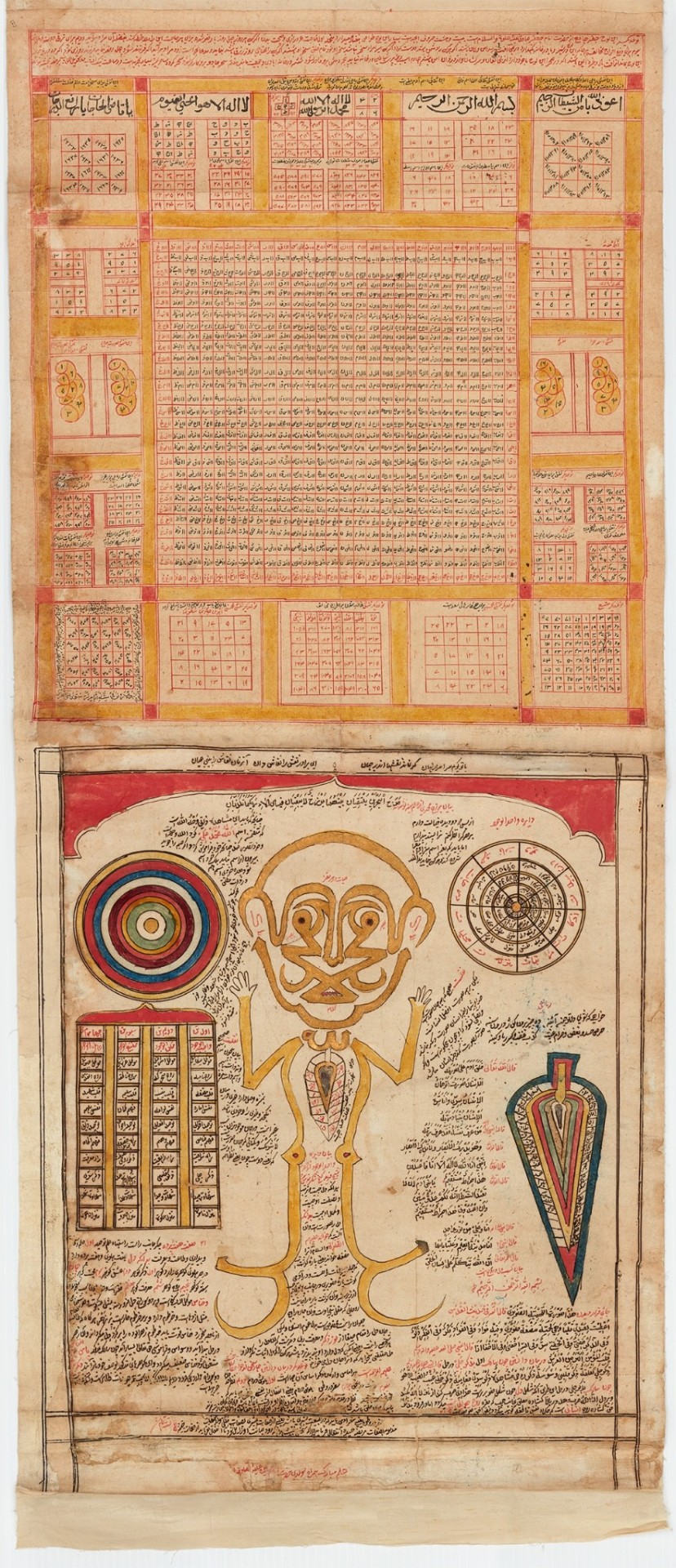
Shiite Talismanic Pilgrimage Scroll
India, probably Deccan, 1787–88
opaque watercolour, black and red ink, and gold on paper; mounted on cloth backing
This monumental scroll measuring more than 900 x 50 cm depicts several major Muslim holy sites, such as the sanctuary of the Ka‘ba and other pilgrimage stops of the Hajj in and around Mecca, as well as Medina, Jerusalem, Karbala, and Najaf. Arranged vertically, these buildings and sites are all oriented towards the Great Mosque in Mecca with the Ka‘ba at the centre; in this manner, the Ka‘ba functions like a magnetic pulse located in the first third of the scroll. Two visual sequences—one starting at the beginning of the scroll marked by a colophon cartouche, and the other at the end of the scroll marked by a calligram (here, a human figure made of calligraphy)—comprise its composition. This scroll has previously been thought to be a Hajj certificate, a document affirming that an identified individual or his/her representative has fulfilled the Hajj or pilgrimage to Mecca and surrounding sites. However, recent research confirms that a considerable portion of the visual repertoire and its inscriptions was composed to increase magic and talismanic functions of this scroll within a clear Shiite context.
#Islam#religion#India#deccan#18th century#1780s#watercolour#ink#gold#talisman#pilgrimage#artifacts#history
46 notes
·
View notes
Text
Constitutional morality is not a natural sentiment. It has to be cultivated. We must realize that our people have yet to learn it. Democracy in India is only a top-dressing on an Indian soil which is essentially undemocratic. - Annihilation of Caste by B. R Ambedkar

Happy India Republic Day! 🇮🇳
#meerathehistorian#meeraedits#india republic day#desi tag#brown history#Annihilation of Caste#B. R Ambedkar#meera bai#jhansi ki rani#rani Lakshmi bai#desi queer#nur juhan#desi quotes#bisexual#queer#lgbtq+#queer history#bi history#history#on this day in history#india#hinduism#islam#islamic history#hindu history#intersectionality#intersectional feminism#anti caste#anti hindutva#queue are made by history
21 notes
·
View notes
Text
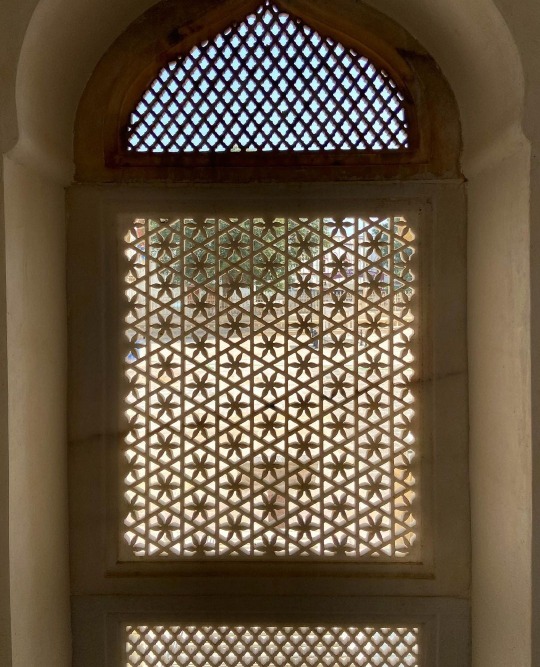
Mahabat Maqbara, India.
Sharang Pawar
#sharang pawar#lacquer walls#marble#mahabat maqbara#gujarat#india#architecture#islamic architecture#indian architecture#desi tumblr#desiblr#desi tag#ph
172 notes
·
View notes
Text
Tw
While Hindoos are facing an open genocide, Islamists are rejoicing and encouraging the mass killing and r@pe of Hindoo women. A Sheikh says that Hindoos only have two options
>to convert
Or
>to die



#hindublr#hinduphobia#desiblr#hindu genocide#bangladesh#bangladesh student protests#islamic jihad#islamist#islamic terrorism#stop genocide#savehindus#sheikh hasina#india#olympics#pagan#paganism#hinduism#hindusunderattack#paganblr
59 notes
·
View notes
Text
Red Fort, Delhi, India. Residence of the Mughal Emperors...






#travel#india#delhi#old delhi#new delhi#mughal architecture#mughal#mughal empire#red fort#indian architecture#islamic architecture#architecture#columns#south asia#asia travel
21 notes
·
View notes
Text


Bitter_truth on Instagram.
40 notes
·
View notes